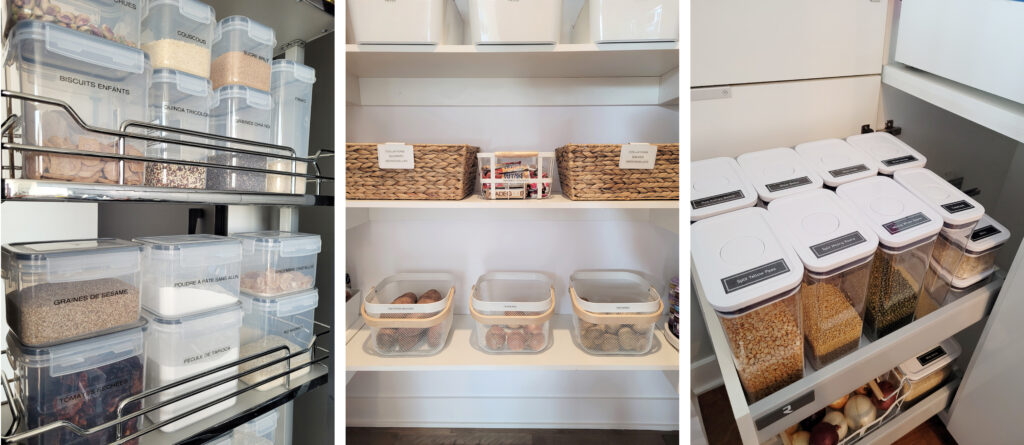
Written by Elizabeth Alescio, professional organizer and founder of Miss Tidy-Up
Who doesn’t dream of a functional and organized pantry? Whether you have a closet with a few shelves or a whole room to store your food in your kitchen, it is possible to optimize and organize this space to better find your way. We all want to avoid wasting food that’s forgotten at the bottom of a shelf, or triple-buying certain foods for nothing.
So here are five key organizational elements that will help you get the most out of your pantry!
1 – GROUPING OF FOODS INTO CATEGORIES
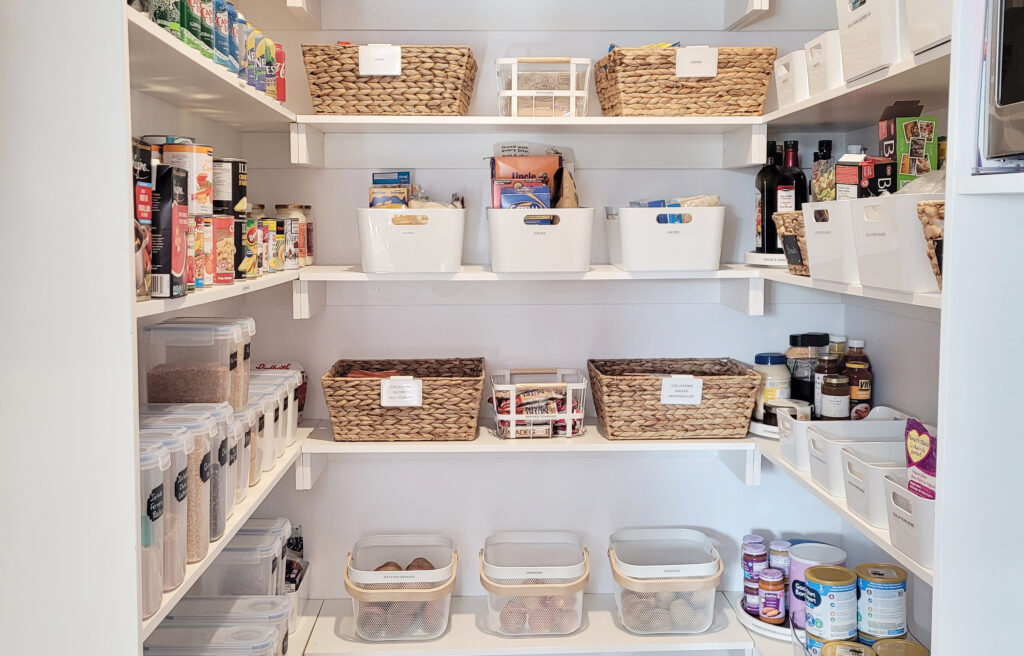
One of the first things to do is to free up a work area to sort food. It’s time to clear out your dining room table, your kitchen island, or both! You’ll need to spread out; you’ll be surprised how much food can come out of your pantry. You may feel overwhelmed during this step, but it is part of the process. It is often chaos before order can reign!
As you go through your items, first eliminate the ones that are expired and also the ones you won’t eat. Group other foods into categories, such as sweet snacks, salty snacks, pasta, grains, rice, baked goods, etc. By grouping foods together, you will have a better idea of how big each category is and it will help you determine where to place them in your pantry.
2 – STRATEGIC FOOD PLACEMENT
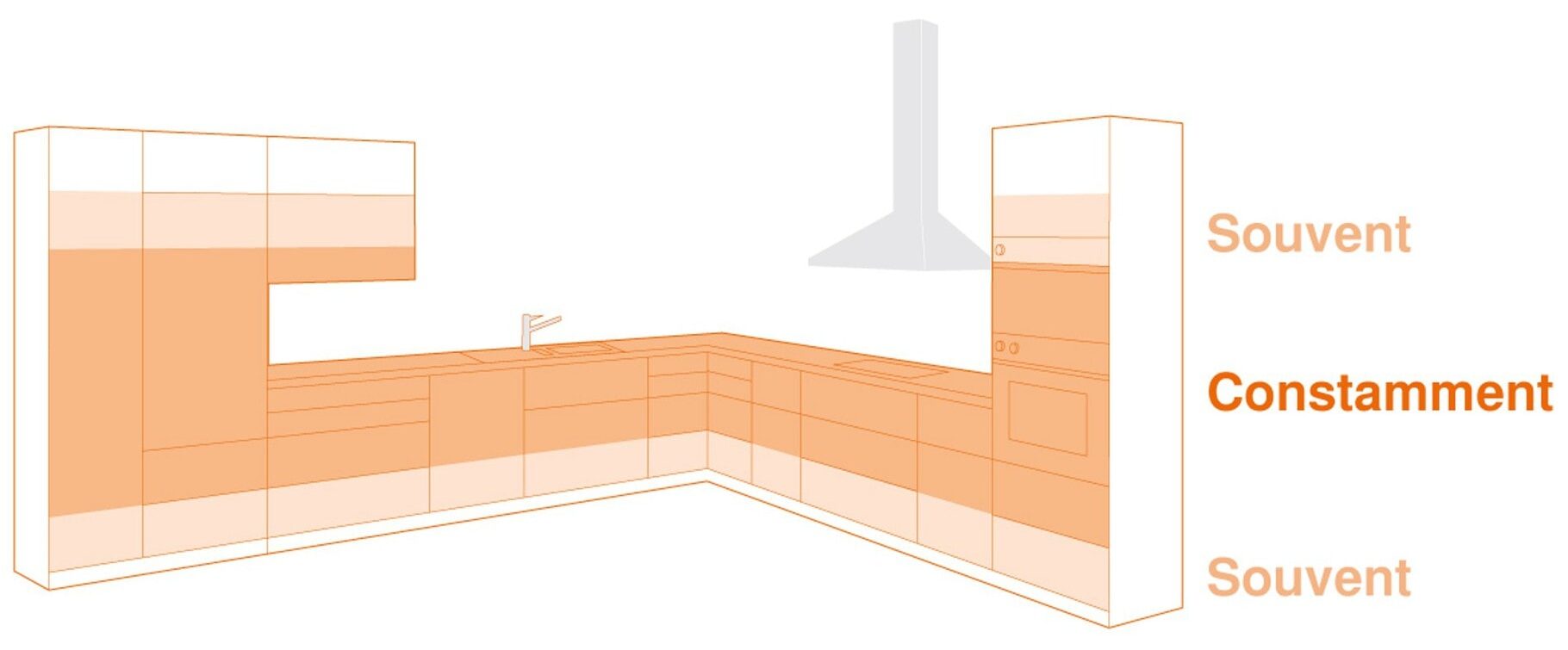
I often talk about three areas of accessibility in a space: the area between the shoulders and knees, the area above the shoulders, and the area between the waist and feet. These areas can also be applied to a pantry, especially in a
walk-in
.
The food you use on a daily basis should be within easy reach, in the area between your shoulders and knees. They will therefore be on the shelves directly in front of you, as this is the area that is most accessible, most visible and requires the least effort. Foods that are rather heavy, such as large bags of flour or bags of potatoes, should be placed lower. Finally, light items that you don’t use often, such as baking items, should be located on the top shelves, above the shoulders. Why not take this opportunity to put “temptation” foods like cookies and chips a little higher up too!
Also, think about who is accessing the food. For example, if children are old enough to pack their own lunches or if you allow them to get snacks from the pantry on their own, consider storing these foods within their reach. I often say that we want to empower our children, so why not allow them that independence and show them where to find certain foods.
The three-zone accessibility rule can be applied to any room in the house. It helps to keep in mind how to better plan the layout of a room.
3- USE OF APPROPRIATE CONTAINERS

It is important to select the right containers for each category of products in order to keep the food as long as possible, but also to store it properly.
I suggest wire baskets for onions or potatoes to circulate the air. They also allow you to quickly see how much of each food item is left in the basket.
You can also opt for airtight containers if you like to decant flours, sugars, cereals, nuts, and dried fruits for example. There are several brands of containers on the market, see which one you prefer. A little advice: choose containers that can be easily washed. Sometimes the edges are difficult to access and there is a risk of mold or some models of containers have several pieces to remove so washing is complicated.
For the rest of the grouped foods, you can select opaque or clear open bins depending on your preference. If you like to see the food in your bin, you may prefer clear bins. On the contrary, if the various food packages are visually distracting, the opaque bins are for you. Essentially, the bins set a physical limit to each food category to prevent overflow and overbuying. For example, if your cracker bin is already If you have a full bag of crackers, ask yourself if you absolutely need another bag of crackers. If so, do you have room to store it in your pantry? You want to avoid overflowing a category for nothing.
Also, I suggest open bins in a pantry for easy access to food. You’ll want to avoid having to lift a lid to pick up an item. This seems logical, but it’s something to think about before you buy the bins.
Also, choose bins that are not too big or too small. If the bins are too big, they will be too heavy to pick up and if they are too small, you won’t be able to store a lot of food and you will need to add more bins.
4- SPACE OPTIMIZATION
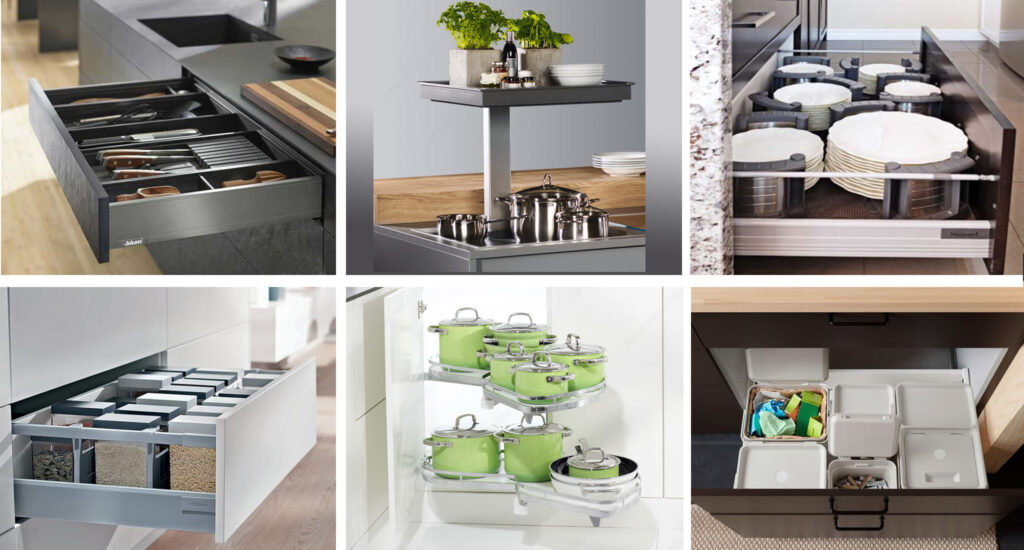
When space is limited, it is even more important to use the available space properly. To optimize the vertical space between two pantry shelves, there are several storage items.
There are baskets that hang on the edge of the shelf. I find them especially useful for lightweight items that you have in small quantities like soft bars. You really need to make sure that you don’t put items that are too heavy on this kind of storage, as it will bend easily.
You can also incorporate tiered displays to store canned goods or spices. In fact, there are three-tiered displays specially designed for preserves with wider shelves than conventional spice racks. The tiered displays provide a clear view of the canned goods and easy access.
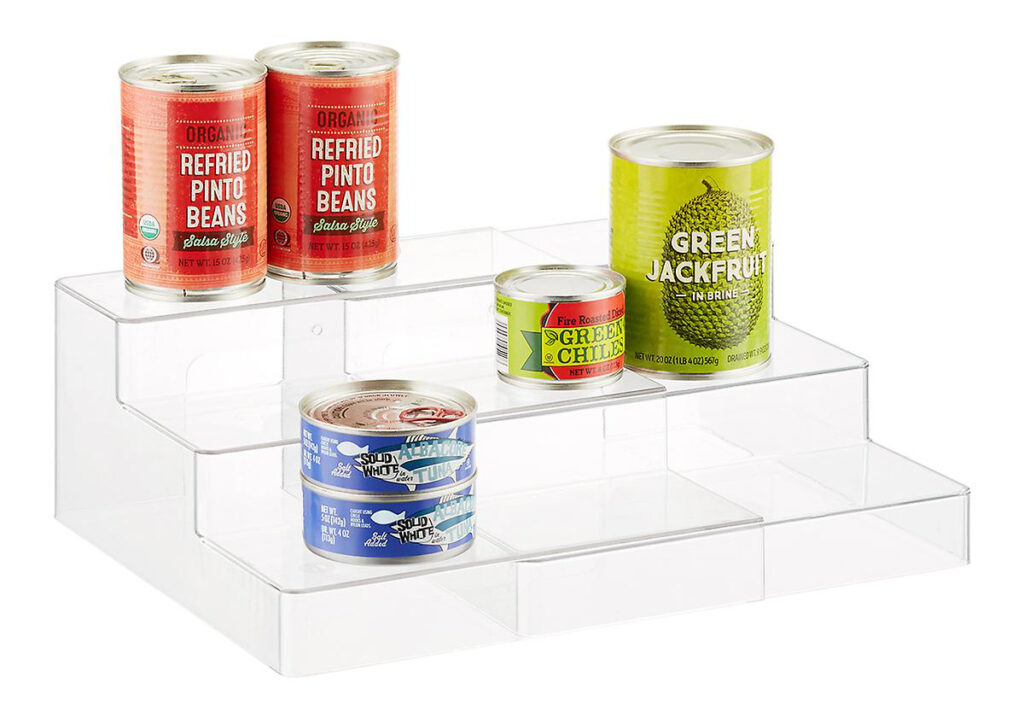
The turntable is another one of my favorite storage products for a pantry. You can store oils and vinegars, bottles of sauces and condiments or spices. I especially recommend them if you have a pantry with right-angled shelves for better access to the corners. Simply turn the tray instead of trying to remove the items in front to access the ones in back.
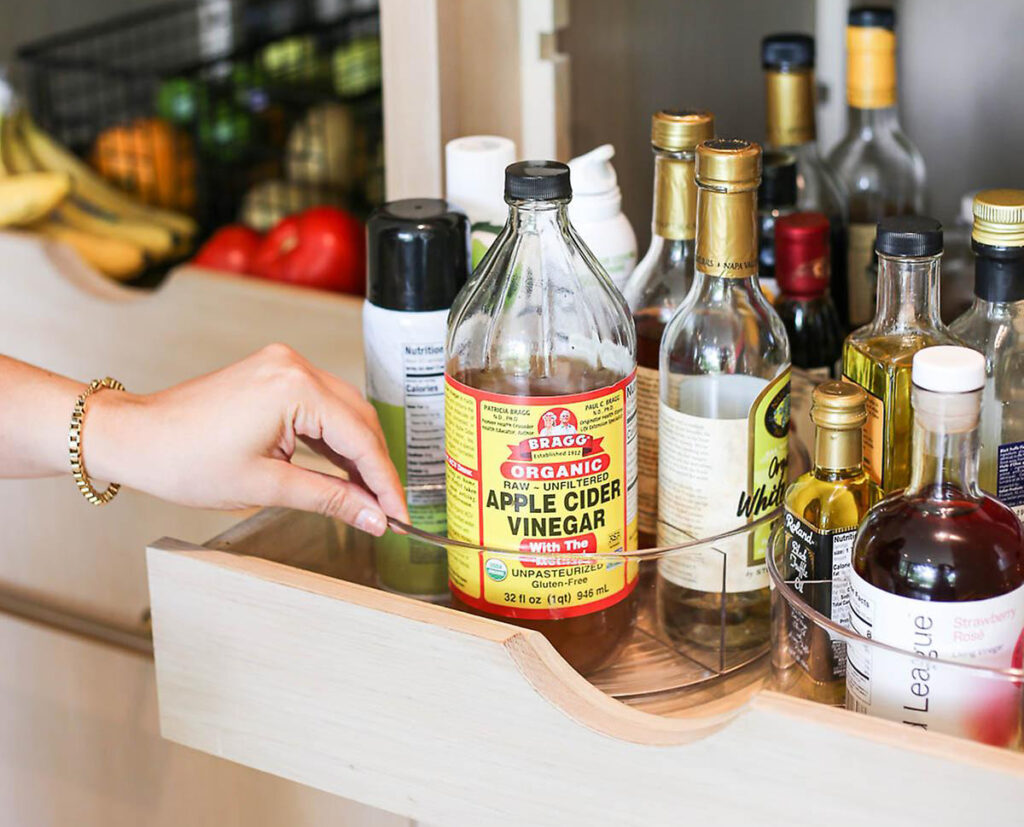
Finally, there are adjustable or non-adjustable shelves that fit on an existing shelf. With this storage item, you’ll double your storage space in a flash. I use them a lot in kitchen cabinets for plates, bowls, cups and glasses, and indeed all over many other rooms in the house to optimize that much forgotten vertical space, but they can work very well in the pantry.
A kitchen designer or an interior designer accompanied by a professional organizer will be able to guide you in your kitchen layout and will suggest storage solutions adapted to your space and your needs.
5- LABELLING
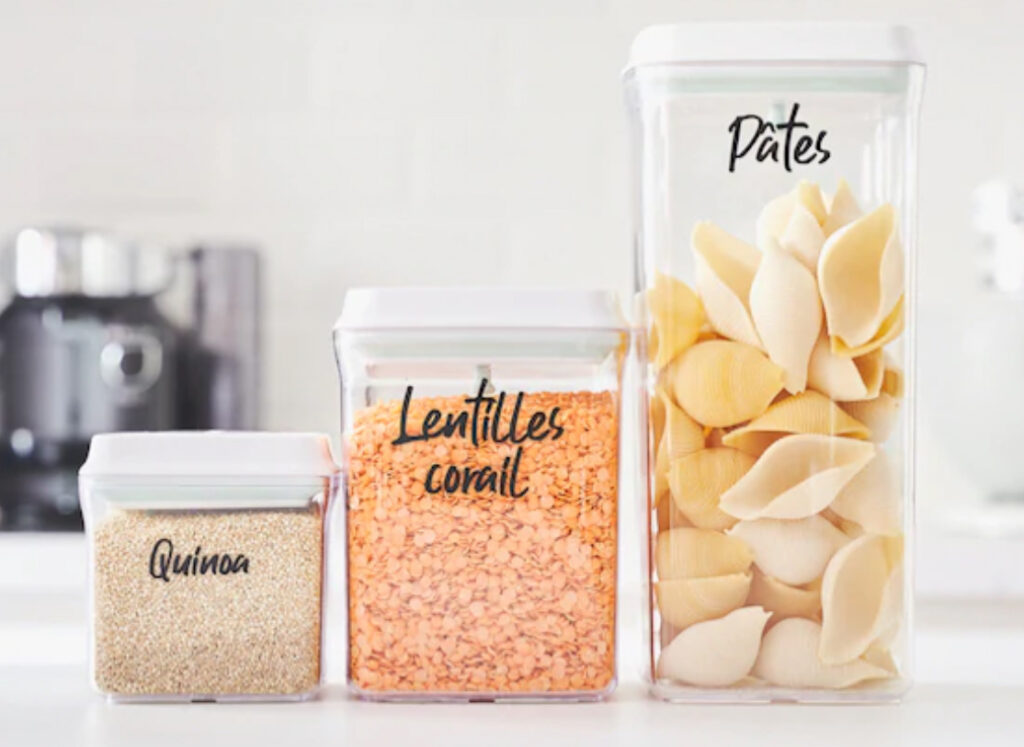
I can’t say it enough, but labeling is part of the success in organization, not to say it is one of the most important steps in the process. Why? In fact, when a space is used by more than one person, labeling is essential to know where to place items.
It is sometimes appropriate to label not only each container, but also the shelf. The shelf label represents the broad category and the product label is more content specific, obviously.
I’m telling you, labels will make your life so much easier. While they make a nice finishing touch to the organization of a space, they are mostly useful! No need to have labels
fancy.
Go with what you like and what works for you: vinyl, slate, paper
post-its
etc. It doesn’t matter, as long as the whole family is involved!
As I mentioned at the beginning, organizing your pantry helps limit food waste and avoid buying duplicate items. The organization of this space also makes it easier to know your inventory to facilitate grocery shopping and meal planning. Ultimately, if you don’t have time to prepare a grocery list, here’s a little trick: take a picture of your pantry. Since every food has its place, and everything is categorized and labeled, you’ll know with a quick glance what you should buy.
By following these key elements, you can better store and use your pantry, no matter how much space it takes up in your kitchen.
Good organization!
Miss Tidy-Up
